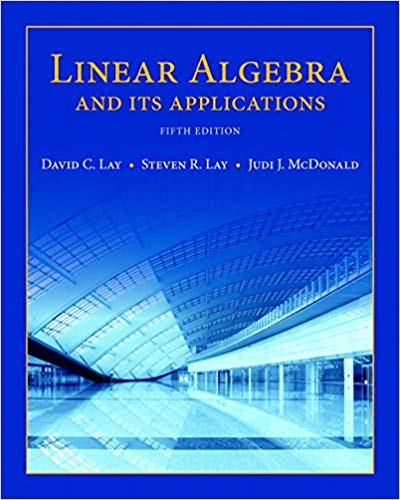
Linear Algebra and Its Applications, 5th Edition
Authors: David C. Lay, Steven R. Lay, Judi J. McDonald
ISBN-13: 978-0321982384
We have solutions for your book!
See our solution for Question 7E from Chapter 4.8 from Lay's Linear Algebra and Its Applications, 5th Edition.
Problem 7E
Chapter:
Problem:
0
Step-by-Step Solution
Given Information
We have to find if the signals $1 ^ { k } , 2 ^ { k } ,$ and $( - 2 ) ^ { k }$ form a basis for the solution space of the equation $y _ { k + 3 } - y _ { k + 2 } - 4 y _ { k + 1 } + 4 y _ { k } = 0$
Step-1:
The Casorati matrix for the given solution. \[ A _ { k } = \left[ \begin{array} { c c c } { 1 ^ { k } } & { 2 ^ { k } } & { ( - 2 ) ^ { k } } \\ { 1 ^ { k + 1 } } & { 2 ^ { k + 1 } } & { ( - 2 ) ^ { k + 1 } } \\ { 1 ^ { k + 2 } } & { 2 ^ { k + 2 } } & { ( - 2 ) ^ { k + 2 } } \end{array} \right] \]
Step-2:
Substitute a value of k, let say k=0 and now reduce the numerical matrix. \[\begin{array}{l} {A_k} = \left[ {\begin{array}{*{20}{c}} {{1^0}}&{{2^0}}&{{{( - 2)}^0}}\\ {{1^1}}&{{2^1}}&{{{( - 2)}^1}}\\ {{1^2}}&{{2^2}}&{{{( - 2)}^2}} \end{array}} \right]\\ = \left[ {\begin{array}{*{20}{c}} 1&1&1\\ 1&2&{ - 2}\\ 1&4&4 \end{array}} \right]\\ = \left[ {\begin{array}{*{20}{c}} 1&1&1\\ 0&1&{ - 3}\\ 0&3&3 \end{array}} \right]::\left\{ \begin{array}{l} {R_2} = {R_2} - {R_1}\\ {R_3} = {R_3} - {R_1} \end{array} \right\}\\ = \left[ {\begin{array}{*{20}{c}} 1&1&1\\ 0&1&{ - 3}\\ 0&0&{ - 6} \end{array}} \right]::\left\{ {{R_3} = {R_3} - 3{R_2}} \right\} \end{array}\] We can see that solution are linearly independent. From Theorem 17 the solution space is exactly three dimensional and the basis theorem in section 4.5 says that a linearly independent set of n vectors in an n-dimensional space automatically a basis. Therefore
The signals $1 ^ { k } , 2 ^ { k } ,$ and $( - 2 ) ^ { k }$ form a basis for the equation $y _ { k + 3 } - y _ { k + 2 } - 4 y _ { k + 1 } + 4 y _ { k } = 0$
We have to find if the signals $1 ^ { k } , 2 ^ { k } ,$ and $( - 2 ) ^ { k }$ form a basis for the solution space of the equation $y _ { k + 3 } - y _ { k + 2 } - 4 y _ { k + 1 } + 4 y _ { k } = 0$
Step-1:
The Casorati matrix for the given solution. \[ A _ { k } = \left[ \begin{array} { c c c } { 1 ^ { k } } & { 2 ^ { k } } & { ( - 2 ) ^ { k } } \\ { 1 ^ { k + 1 } } & { 2 ^ { k + 1 } } & { ( - 2 ) ^ { k + 1 } } \\ { 1 ^ { k + 2 } } & { 2 ^ { k + 2 } } & { ( - 2 ) ^ { k + 2 } } \end{array} \right] \]
Step-2:
Substitute a value of k, let say k=0 and now reduce the numerical matrix. \[\begin{array}{l} {A_k} = \left[ {\begin{array}{*{20}{c}} {{1^0}}&{{2^0}}&{{{( - 2)}^0}}\\ {{1^1}}&{{2^1}}&{{{( - 2)}^1}}\\ {{1^2}}&{{2^2}}&{{{( - 2)}^2}} \end{array}} \right]\\ = \left[ {\begin{array}{*{20}{c}} 1&1&1\\ 1&2&{ - 2}\\ 1&4&4 \end{array}} \right]\\ = \left[ {\begin{array}{*{20}{c}} 1&1&1\\ 0&1&{ - 3}\\ 0&3&3 \end{array}} \right]::\left\{ \begin{array}{l} {R_2} = {R_2} - {R_1}\\ {R_3} = {R_3} - {R_1} \end{array} \right\}\\ = \left[ {\begin{array}{*{20}{c}} 1&1&1\\ 0&1&{ - 3}\\ 0&0&{ - 6} \end{array}} \right]::\left\{ {{R_3} = {R_3} - 3{R_2}} \right\} \end{array}\] We can see that solution are linearly independent. From Theorem 17 the solution space is exactly three dimensional and the basis theorem in section 4.5 says that a linearly independent set of n vectors in an n-dimensional space automatically a basis. Therefore
The signals $1 ^ { k } , 2 ^ { k } ,$ and $( - 2 ) ^ { k }$ form a basis for the equation $y _ { k + 3 } - y _ { k + 2 } - 4 y _ { k + 1 } + 4 y _ { k } = 0$